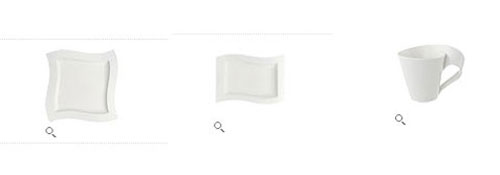The Great Plate Debate
 You may not know Villeroy & Boch Hot Wave plates by name, but if you’ve dined in a restaurant in Philly in the past decade, you’ve seen them. These are the dishes with the distinct curvy silhouette that were once unusual (they’re square! And wavy!) and are now ubiquitous. Not to mention dated. I’ve always found them to be ugly and awkward. You might disagree (this is the internet; undoubtedly you’ll be disagreeing. Loudly). Here are photos of the offending parties:
You may not know Villeroy & Boch Hot Wave plates by name, but if you’ve dined in a restaurant in Philly in the past decade, you’ve seen them. These are the dishes with the distinct curvy silhouette that were once unusual (they’re square! And wavy!) and are now ubiquitous. Not to mention dated. I’ve always found them to be ugly and awkward. You might disagree (this is the internet; undoubtedly you’ll be disagreeing. Loudly). Here are photos of the offending parties:
Are the restaurants trying to telegraph something by using them? Judging from my experience, they’re trying to telegraph that if you serve something on these plates, you can charge an extra $5 for it. Even if it doesn’t taste good.
So why do so many restaurants want to use them? It’s one of the great unsolved mysteries of the dining universe, like why some chefs think squirting squiggles of sauce across a plate, courtesy of the ol’ squeeze bottle, is somehow elevating the presentation of the dish, instead of making it look as au courant as a pair of Hammer pants. Maybe people are lulled by the rhythm of the Hot Waves.
But there are more problematic plates out there.
Here is what I like in a plate: It should be round. More important, it should have a distinct lip, so that food does not slide off the edge of it onto the table or one’s lap. This past weekend, at a Restaurant That Shall Not Be Named, my husband and I were given small rectangular share plates — they seemed more appropriate for use as check presenters — with no lip. I don’t know who makes them (or why), but I knew they were going to be trouble. They had neither a curved edge or even a slight upturn to prevent pieces of food from flying across the table as we sliced and scooped. And sure enough, as we ate our way through six shared dishes, as we attempted to cut through lamb loin, lettuce leaves and (rubbery) octopus, we spent much of the time accidentally flinging food towards each other. It was funny — especially since work was paying the bill — but had I been forking over my own dollars, I would have been really disappointed that more of my food ended up on the table than in my mouth.
Speaking of forking, I might as well go into cutlery. What’s with the forks with three tines? A fork should have at least four tines. If it has three tines, it’s called a trident and if you’re the person wielding it, congratulations! You are Poseidon, the mythical Greek god who rules the sea.
Spoons. Spoons should not be so enormous that it’s impossible to fit them into your mouth. The place for oversized silverware is Medieval Times, where you’ll also be hauling an entire turkey drumstick up to your mouth while wearing a hairshirt and ordering mead from a “serving wench.”
And those knives that you have to balance on their blade instead of on their sides? Why? Aren’t we already anxious enough as a nation without having to worry about keeping our dinner knives poised on a razor-sharp edge during dinner? I’m pretty sure my blood pressure shot up just writing about it.
I think what really bothers me about this is the idea that restaurateurs are putting the presentation of their food and the aesthetics at a higher premium than the comfort of the guests. And while visual components of a dish are very important—I like nothing better than a pretty-as-a-picture composition of ingredients — what about what happens when you pick up your and knife and attempt to cut through a tender little lamb chop and find it slipping and sliding all over the plate — and possibly into your dining partner’s lap? It’s favoring form over functionality and when it means you’re unable to eat the food you just paid for, there’s nothing pretty about it.



